#basal tetrapods
Text
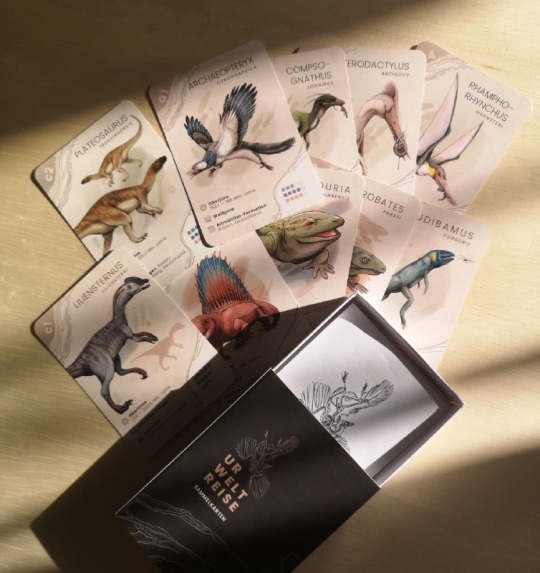
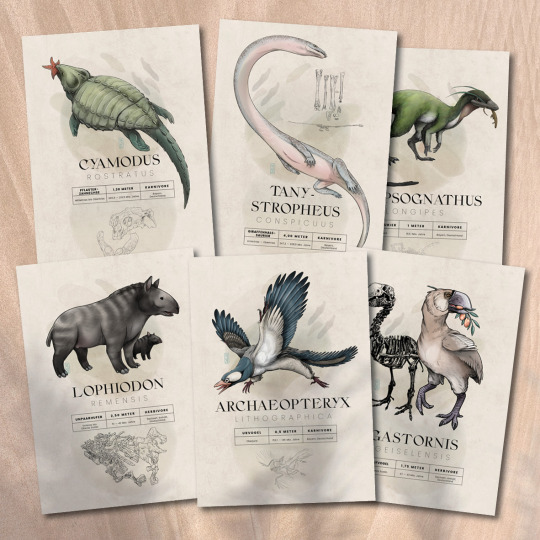

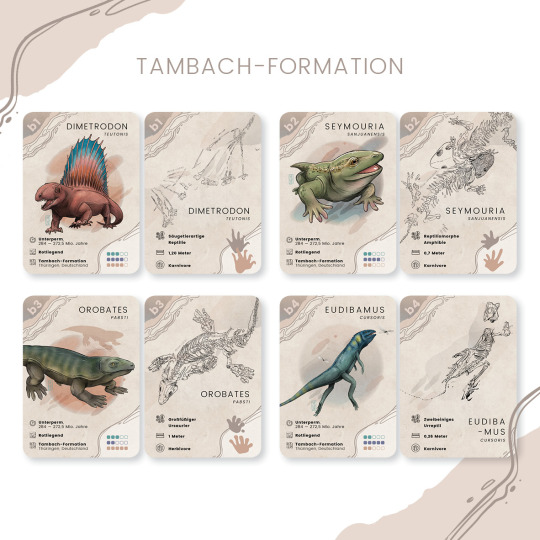
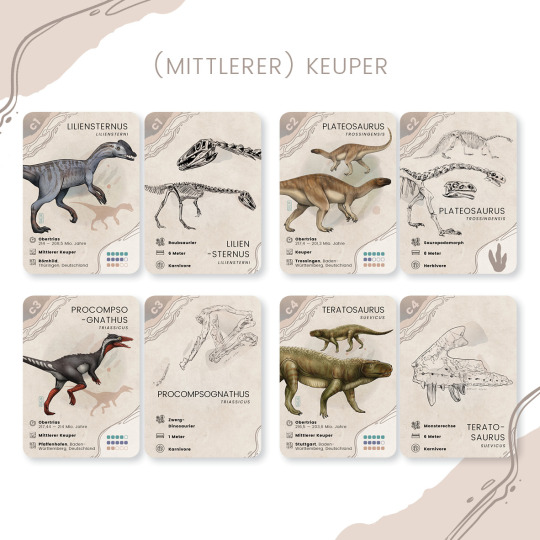
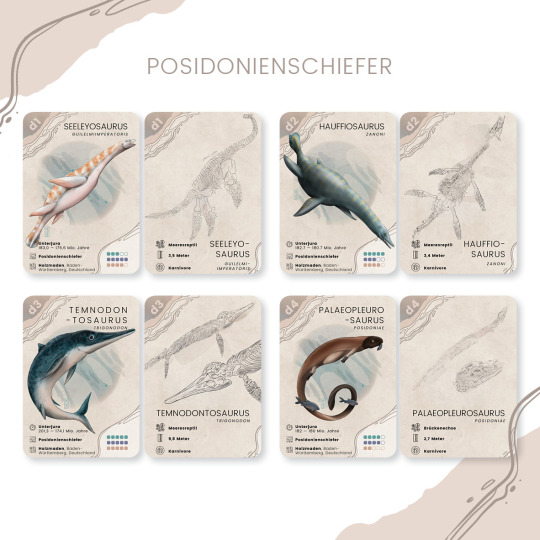


Last year, I created a trading card game concept featuring local paleo fauna of different formations. I want to produce a professional set this year and maybe an English edition as well.
The German trading cards concepts and pins will soon be available again in my online shop.
#paleoart#paleontology#scince illustration#digital illustration#trading cards#dinosaurs#basal tetrapods#synapsids#pterosaurs#natural history#archaeopteryx#dimetrodon
654 notes
·
View notes
Text
why are there zero good references for megalocephalus or literally any other of the baphetids…….. dies
#Baphetids#Tetrapods#Basal tetrapods#Please if someone has a side view of any of the baphetids I will give you a big smooch#rainbles
0 notes
Text
currently very very sad about how hard it is to learn more about ancient amphibians (particularly temnospondyls) because i KNOW theyre interesting and WILD AS FUCK but its hard to find a lot of solid information about them
#all the care guide says is 'biomass'#god modern amphibians are WEIRD#because we so much use them as the picture of what a basal tetrapod would look like#except no they arent at all like their ancestors and theyre like#retroactively 'primitive'
2 notes
·
View notes
Text
Why are slimes placed as an early branch off of the kingdom Animalia?
Slimes are enigmatic. Taken at face value, they could fit anywhere or nowhere in the tree. They tick all of the boxes required to be defined as an animal, but don’t closely resemble any real phylum, though they do bear some resemblance to certain basal animal groups such as ctenophores and cnidarians.
Why is the elytra branching off from the insects?
The word elytra refers to the hard wings of beetles. This is where beetles would be placed on the tree.
Why is the shulker a mollusk?
It’s a shelled invertebrate - anything beyond this is unclear. It has a pair of shells like a bivalve, but could belong to any of a number of different related groups.
Why is the sea pickle so close to vertebrates?
The sea pickle is either based on a real life sea cucumber (an echinoderm), or a sea pickle (a tunicate). Either way, both of these groups are deuterostomes, which means they, like us, develop their anus before their mouth. Yeah.
Why are guardians labeled as manufactured?
It’s an idea I’m not totally sold on, but a theory nevertheless. It has been posited that guardians were created to guard underwater monuments and are not actually animals. I am of the opinion that if this is the case, they are still at least partially biological, as they do drop edible raw fish. In this case, they likely represent a lineage of jawless fish comparable to real life ostracoderms that was further modified for their role as temple guardians.
Why are the dragon and sniffer related? Why do they branch off the tree so early?
Both are 6 limbed, meaning they are not tetrapods, the group which includes all real terrestrial vertebrates. Instead, they may represent a different lineage of fishes which separately developed a third limb girdle and then followed a line of parallel evolution with the tetrapods. This is comparable to the various invasions of land by arthropods, in which arachnids, myriapods and insects separately evolved mechanisms of terrestrialization while also convergently evolving many of the same structures as each other.
Aren’t creepers described as “plant-like?” Why are they included with the vertebrates?
They have indeed often been described as plant-like by various developers. It is my belief that they are vertebrates with a symbiotic relationship with some form of plant, probably a moss. This is why they are also included in Bryophyta on the other side of the tree. All promotional merchandise that shows creeper internal anatomy shows the presence of bones and the general anatomy reflects a familiar yet distorted version of the common tetrapod body plan. They do not share much in common with either reptiles or mammals, and so I split them off early in the vertebrate portion of the tree. While creepers share a developmental history with pigs, they do not actually bear any synapomorphies to suggest this relationship is canon, and so I chose not to place them nearby.
Why are phantoms reptiles?
I’m honestly not sure what else they could be. The underside of the texture reminds me of the plastron of a turtle, though the wings are arguably more bat-like than anything else. Phantoms are all undead and their living version is likely now extinct, so we can’t fully understand the anatomy they would have had.
Why are striders synapsids? What is a synapsid?
Synapsids are mammals and their extinct, reptile-like ancestors. Striders have hair, like living mammals, but otherwise share very little with modern mammals, suggesting they split off early in synapsid evolution.
What is the warden/sculk?
I don’t know. It’s very purposefully the most alien life in Minecraft. Most realistically, I think it’s not from the overworld at all. However, that’s not really in the spirit of this project. Therefore, I hypothetically place it as a fungus, as fungi are capable of the sprawling growth in dark environments and possible parasitism in the case of the warden itself.
Why are blazes labeled as “manufactured?”
I haven’t got a clue what blazes could be. Are they sentient fire? Are they living creatures that mimic fire? Who knows. I finally ended up considering them to be something akin to vexes or golems - summoned by someone or something to guard nether fortresses, rather than naturally evolved creatures. This is actually supported by a really old (and likely since retconned) article from the Minecraft website. https://www.minecraft.net/en-us/article/visit-nether-
Why is glow lichen connected to two separate branches?
Because lichen is a symbiotic structure formed by both algae and fungi!
Why are chorus plants where they are?
They are angiosperms, meaning they bear flowers and fruit, but do not have the characteristics of either of the more derived major lineages of flowering plants.
Why are dripleaf plants alismatales?
To me, they bear a great resemblance to members of the arum family, such as elephant ear plants, arrowhead plants, and Monstera.
Torchflower?
It bears greatest resemblance to bromeliads, a group of plants related to grasses.
Why is the spore blossom placed where it is?
The spore blossom is another anomalous species. If “spore” is taken seriously, it must be a fern. However, ferns don’t have flowers, so I assumed the spores are actually just pollen. I placed it as a dicot based on the fact that dicots typically have flowers with 4-5 petals, while monocots have flowers with petals in multiples of 3.
Why aren’t vines and glow berry vines placed together?
The “vine” form has evolved dozens of times in separate lineages of plants, just like the “tree” form. It alone is not enough to indicate a close relationship. I tentatively placed vines where the grape family would go, and placed the glow berries where staff vines (Celastrus) should be.
Why aren’t dead bushes grouped with sweet berry bushes and azaleas?
Like vines and trees, “bush” is a description of a body form and not an evolutionary group. I depicted the dead bush as a real form of desert bush, a tumbleweed, specifically the Russian thistle, a common tumbleweed in the order Caryophyllales.
Sweet berries, on the other hand, are most likely based on lingonberries, a commonly grown crop in Sweden, where Mojang is based. These belong to the order Ericales along with azaleas, as well as many other common plants not yet represented in the game such as blueberries and cranberries.
Pitcher plants are real - why isn’t there a “confirmed” lineage on the tree?
Pitcher plants have evolved several times in different lineages, and there is no clear indication which ones the ones in Minecraft are. In fact, most likely, the Minecraft pitcher plants don’t belong to any real group of pitcher plants, as none of these produce “pods” nor do they have similar leaves. However, the most likely candidates are the family Nepenthaceae (order Caryophylalles) or the family Sarraceniaceae (order Ericales).
193 notes
·
View notes
Note
Using phylogeny to horribly warp the definition of a fish, my favourite fish is probably the binturong (Although all procyonids are also incredible). There's just something great about a mid-sized feliform with a semi-prehensile tail and a smell of popcorn about it. Plus they sometimes look like haggard old men and it's fantastic.
Using fish to mean things people classically refer to as fish, I love polypterids (Bichir) etc. I love the fact some of them can move around on land, I love how basal they are to all the other ray finned fish (Nothing against other ray finned fish, there's just something charming about lonely branches on the tree of life to me), I love their shapes, I love the fact reedfish/ropefish look like they're smiling. I love the fact they (and everyone walking past) will side eye me if I baby talk them at my nearest aquarist. A tier fish, one day I will live in a place large enough to have one.
Fine tetrapod and true fish choices! Bichirs are cool fish indeed, I don’t think I appreciate them enough for just how cool they are; they even have lungs!! I’ll need to research them a bit more, it’s clear, and spread bichir joy in the world.
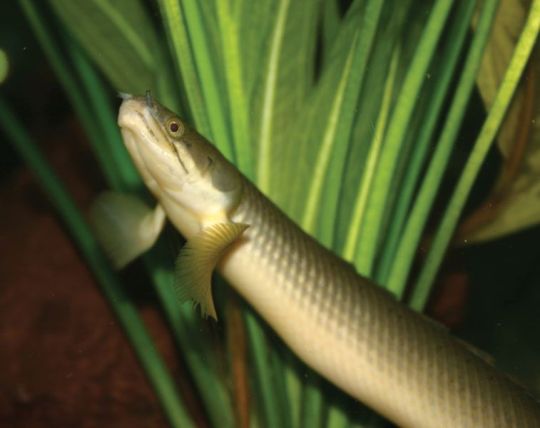
Binturong joy, too. Unappreciated animals deserve recognition! Plus they literally look like this:

If the Muskrat from the Moomins wasn’t already a, you know, muskrat…. He should’ve been this. 100%. Perfect nihilistic philosopher.
24 notes
·
View notes
Text
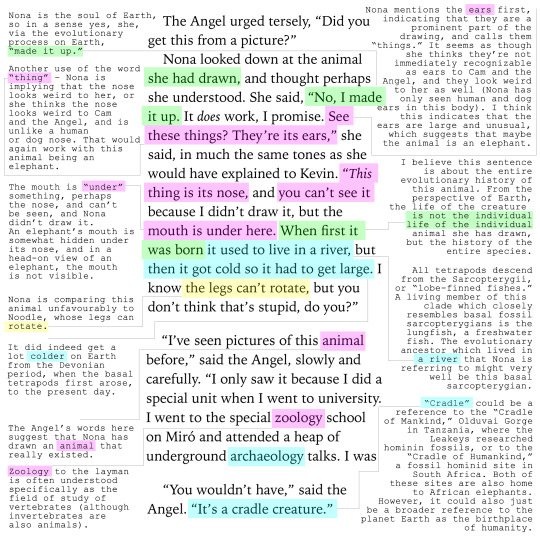
🐘 Is the "cradle creature" in Nona's drawing an elephant?
Image description and transcript:
Annotation of three quotes from Nona the Ninth. Areas with brackets have colour-coded annotations. The annotations will follow.
The Angel urged tersely, "Did you I get this from a picture?"
Nona looked down at the animal she had drawn, and thought perhaps she understood. She said, (“No, I made it up.) It does work, I promise. (See these things? They're its ears,") she said, in much the same tones as she would have explained to Kevin. ("This thing is its nose,) and (you can't see it because I didn't draw it, but the mouth is under here.) (When first it was born) (it used to live in a river, but then it got cold so it had to get large.) I know (the legs can't rotate,) but you don't think that's stupid, do you?"
"I've seen pictures of this (animal) before," said the Angel, slowly and carefully. "I only saw it because I did a special unit when I went to university. I went to the special (zoology) school on Miró and attended a heap of underground archaeology talks.
"You wouldn't have," said the Angel. "It's a cradle creature."
Nona is the soul of Earth, so in a sense yes, she, via the evolutionary process on Earth, “made [this creature] up.”
Nona mentions the ears first, indicating that they are a prominent part of the drawing, and calls them “things.” It seems as though she thinks they’re not immediately recognizable as ears to Cam and the Angel, and they look weird to her as well (Nona has only ever seen human and dog ears in this body). I think this indicates that the ears are large and unusual, which suggests that maybe this animal is an elephant.
Another use of the word “thing” [in reference to the nose] – Nona is implying that the nose looks weird to her, or she thinks the nose looks weird to Cam and the Angel, and is unlike a human or dog nose. That would again work with this animal being an elephant.
The mouth is "under" something, perhaps the nose, and can't be seen, and Nona didn't draw it. An elephant's mouth is somewhat hidden under its nose, and in a head-on view of an elephant, the mouth is not visible.
Nona is comparing this animal unfavourably to Noodle, whose legs can rotate.
I believe this sentence [“When first it was born…”] is about the entire evolutionary history of this animal. From the perspective of Earth, the life of the creature is not the individual life of the individual animal she has drawn, but the history of the entire species.
All tetrapods descend from the Sarcopterygii, or "lobe-finned fishes." A living member of this clade which closely resembles basal fossil sarcopterygians is the lungfish, a freshwater fish. The evolutionary ancestor which lived in a river that Nona is referring to might very well be this basal sarcopterygian.
It did indeed get a lot colder on Earth from the Devonian period, when the basal tetrapods first arose, to the present day.
The Angel's words here suggest that Nona has drawn an animal that really existed.
Zoology to the layman is often understood specifically as the field of study of vertebrates (although invertebrates are also animals).
"Cradle" could be a reference to the "Cradle of Mankind," Olduvai Gorge in Tanzania, where the Leakeys researched hominin fossils, or to the "Cradle of Humankind," a fossil hominid site in South Africa. Both of these sites are also home to African elephants. However, it could also just be a broader reference to the planet Earth as the birthplace of humanity.
452 notes
·
View notes
Text
Ossinodus pueri

Ossinodus was a genus of stem tetrapod from the Early Carboniferous. Its type species is O. pueri. The known specimens were found in the Druckabrook Formation in Queensland, Australia. Its fossils include the oldest known pathological bone in a tetrapod, which is a healed fracture on a right radius.
Its formal diagnosis does not include any autapomorphies, but the authors found the combination of its features to be enough to warrant the creation of a new genus and species. While most of its traits are shared with other members of Whatcheeriidae, it does have a broader and shallower skull than Whatcheeria and was generally larger than both Whatcheeria and Pederpes, which is its most distinguishing quality.
Its placement amongst other stem tetrapods is debated, but it has been supported that it is closely related, if not included within, Whatcheeriidae. The possible absence of an intertemporal bone, a small bone on the skull above the eye, would place it more basally to Whatcheeriidae as a sister taxon to the family. There are five known specimens of O. pueri, all found at the same time from the same formation, that vary in size and are thought to represent both juvenile and adult creatures. Its most famous fossil, the radius with a healed fracture, indicates it is the oldest known large tetrapod to have spent substantial time on land, as it was found that the pressure exerted on the bone to fracture it could have only come from falling off of a height of about three feet. Its healing also appears to have continually remodeled the bone in response to supporting weight, something that would not have occurred if it spent all its time in the water.
Original paper: https://onlinelibrary.wiley.com/doi/10.1111/j.0031-0239.2004.00353.x
Wikipedia article: https://en.wikipedia.org/wiki/Ossinodus
#tetrapods#stem tetrapod#paleoart#paleontology#artwork#original art#original artwork#human artist#ossinodus#whatcheeriidae#tetrapoda#obscure fossil animals#obscure fossil tetrapods
8 notes
·
View notes
Text
However, Feduccia’s critique of the dinosaur-bird hypothesis is not based just on problems with the fossil record, but also on conflicting evidence from comparative anatomy.
Now, he presents new evidence that still more sharply contradicts the consensus view. One of the arguments for a dinosaur-bird relationship has been the presence of a so-called “open” acetabulum, which “is a concave pelvic surface formed by the ilium, ischium, and pubis, which accommodates the head of the femur in tetrapods.” Feduccia (2024) studied the acetabulum in early basal birds and found that their acetabulum tends to be partially closed and an antitrochanter (process of the ischium or iliac) is absent.
3 notes
·
View notes
Note
I remember you went with hooves for anthropromorphic whales because of their evolutionary line and family, but how would you go about it with fish? Would you take the same route or use the more lizard-like webbed features of the Tulerpeton
See i havent taken ichthyology so i dont know nearly as much about what forms fish limbs take and how basal terrestrial fish work. i at least know its lobe finned fish we should probably be looking at but like not all fishes translate to a tetrapod layout which anthros are. im this way with anthro birds too, i take obviously highly modified limbs and just kind of squish them back into armlike/leglike forms, i look at ancestral birds and their skeletons and just give them back their digits.
Not all fish lineages went in a tetrapod direction, in fact not all fish lineages have limbs at all, so you cant exactly rewind them. If those lineages were to eventually become terrestrial who knows what their limbs would look like if any. But as for now i think anthro fish would just take on whatever form makes sense for them. Scaly claws, mucusy smooth skin, whatever story their body is telling. A lot more creativity and filling in the blanks with anthro fishes
3 notes
·
View notes
Text
The Planimals of Sinirin: A Basic Guide
Domain: Eukaryota
(Unranked): Diaphoretickes
(Unranked): SAR supergroup
Kingdom: Zoophyta
Planimals (more properly referred to as zoophytes, but most people don’t call them that outside of scientific discussions) are a kingdom of organisms which have traits associated with both plants and animals (although they are more closely related to plants). Most of them are heavily dependent on magic to survive. The vast majority of terrestrial species inhabit the continent of Ael.
General Traits
Most planimals have cell membranes with cortical alveoli, although some groups have evolved cell walls. Similarly to their ancestors, they have two nuclei: the micronucleus (holds the DNA passed on to offspring) and macronucleus (actively regulates the cell and phenotype of the organism).
They have three types of plastids: chloroplasts, chromoplasts, and elaioplasts (clusters of which replace animal-like fat tissue). The latter two are convergently evolved with those of plants.
Autotrophic, mixotrophic, and heterotrophic planimals exist. The ones that photosynthesize use chlorophylls a and c.
All planimals are oogamous (produce gametes of different size / shape / motility). Some phyla have alternation of generations. Viviparity is rare. They do not produce flowers or fruit.
Evolution
Planimals branched off from ciliates about 400 million years ago. They were exclusively aquatic until 250 million years ago, when the first terrestrial planimals came ashore on what is now the continent of Ael.
Planimals gained the ability to detect and make use of magic early on in their evolution. At some point, they began to use magic to supplement their naturally less-efficient biological processes, like photosynthesis. This allowed them to become more and more complex without changing any of their biological processes, which in turn made them more and more dependent on magic. Most modern-day planimals will die rapidly if deprived of it.
Major Phyla
Tapetozoa (“carpet animals”): Among the most basal extant planimals. Resemble gigantic amoebas or placozoans with a covering of thin but tough green skin. Both aquatic and terrestrial species exist. Notably, all species can survive just fine in low- or no-magic spaces.
Archodendrons (“ruling trees”): A clade resembling trees. A number of species produce small motile “seed/egg-pods” which carry their contents to the nearest sperm-producing archodendron. (Their name comes from their seeming command over these pods.) Despite their appearance, they have animal-like flesh and blood (albeit in different colours - yellowish flesh and clear blood) underneath their “bark”.
Xylovertebrata (“wood-spines”): Vertebrate, including tetrapod, analogues. Their bones superficially resemble bamboo wood, hence the name. Alternation of generations is a common trait.
Florafoliognatha (“flower petal-jaws”): The other vertebrate analogues, sort of. They have internal skeletons, but a number of traits reminiscent of arthropods: 3 - 5 sets of limbs, multiple sets of jaws, and ventral nerve cords. Out of all planimal phyla, they have the most heterotrophs and facultative autotrophs among their ranks. Those species’ lack of reliance on sunlight has allowed them to exploit new niches, like subterranean and deeper-sea habitats. They also have the most nocturnal species.
#worldbuilding#fantasy biology#speculative biology#planimals#Sinirin#no pictures again sorry - haven’t been feeling very visually-artistic lately
4 notes
·
View notes
Text
Folks like to use that ‘push the basal tetrapod back in the water’ meme for twitter users trying to come on tumblr, but surely we’re more fish trying to push a whale ancestor back on land.
They left to something new trying to come back. It fits better.
8 notes
·
View notes
Text
I just used the phrase "mammalgirl" to describe all the potentialities of my usage of :3 type emoticons and I'm laughing to myself because like... yeah girls ARE mammals. I think other tetrapods should be free from the bonds of gender.
I ALSO realized last night that the two most derived reptile lineages, the mammals and the birds BOTH build complex nests, whereas more basal reptiles seem to mostly just use shallow pits or burrows. Not sure what to make of that or if it's even accurate.
#punkblogging#these thoughts aren't necessarily connected in any way but they both fall under 'non definitional mammal vs non mammal distinctions'
2 notes
·
View notes
Text
Taxonomy 0: Introduction
Part 1 (Biota) →
This is the introductory post for a series on taxonomy, i.e. the classification of living organisms, that I’m planning. It will be an overview of the whole tree of Life on Earth with examples and simple descriptions of the most important groups. This post contains definitions of a few key terms and notes on the writing conventions I will use.
First of all, an example of phylogenetic tree with 11 members, of which 5, written in black, are living and 6, written in gray, are extinct (full explanation under the cut):

Original post
Such a tree is organized around nodes connected by branches. Look at the node labeled “Aves”, in the red box: that one represents the origin of modern birds, and it gives off two branches, ending in the nodes labeled “Paleognathae” and “Neognathae” -- the two main groups into which modern birds are divided.
As a natural consequence of evolution, species and groups of species form a pattern called a nested hierarchy: in brief, its sets within sets within sets. The group “Aves” nests inside “Theropoda”, which nests inside “Saurischia”, which nests inside “Dinosauria”, and so on until the root of this particular tree, which is labeled “Amniota”, and contains all reptiles, birds, and mammals. All the branches splitting from the node labeled “Aves” belong to that group, so all birds are Aves. Similarly, all groups named in this diagram are Amniota, because they all branch forth from the node labeled “Amniota”. A sub-group that branches away early, near the root (such as Sphenacodontia within Synapsida), is said to be basal.
Each node other than the terminal ones represents the Last Common Ancestor (LCA, or “concestor” in Dawkins’ terminology) of a particular set of species. For example, the node labeled “Aves” corresponds to the Last Common Ancestor of all living birds, that is, the most recent species that is a direct ancestor of all bird species living today.
Whenever a node gives off two branches (which represents an ancestral species giving rise to two distinct descendants), we say these branches are sister groups, which simply means that they’re each other closest relation. In this diagram, Synapsida and Sauropsida, marked by red dots, are each other’s sister group, as are for example Saurischia and Ornitischia, or Neognathae and Paleognathae.
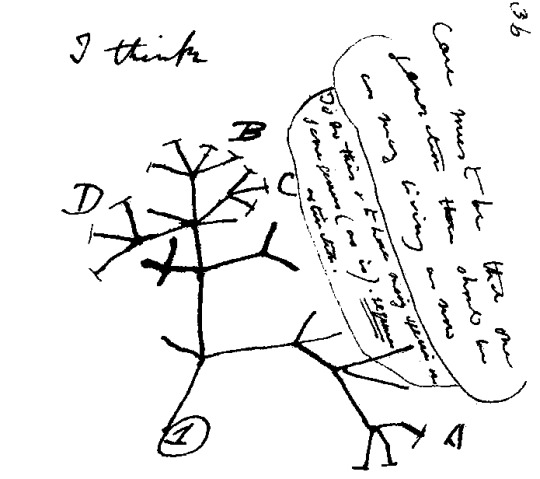
From Wikipedia. Charles Darwin’s first sketch of an evolutionary tree diagram (1837).
Any group of species linked by evolutionary relations is called a taxon (plural taxa). Now, there are many ways to define taxa, but the gold standard is the monophyletic group or clade. Such a group, the only kind held to be valid in cladistics, is composed of the LCA of a certain set of species, all the LCA’s descendants, and nothing else. (See the purple, solid-lined box in the diagram, corresponding to the clade Synapsida, which contains all and only the descendants of the ancestral synapsid.)
Sometimes you want to exclude some of the LCA’s descendants for the purpose of classification. A paraphyletic group is composed of the LCA of a certain set of species and some, but not all, its descendants. The concept of “reptile” is an example: birds are also descendants of the LCA of all reptiles, but they are left out of the group. This is not admitted in cladistics, but it’s not necessarily meaningless: it’s possible for a paraphyletic group to share features that are lacked by the excluded sub-group. For example, “reptiles” generally have scaly skins, teeth, and lack feathers, which is not the case for birds. In such a case, a paraphyletic group can be called a grade. (Other examples of grades are “invertebrates”, “green algae”, “fish”, and “crustaceans”, which exclude vertebrates, land plants, tetrapods, and insects, respectively; or the cyan dashed-lines “mammal-like reptile” box in the diagram, which excludes mammals.)
Finally, we have polyphyletic groups. These are effectively groups with multiple independent origins: they are composed of a certain set of species, but not their LCA. Descriptive terms such as “trees” or “warm-blooded animals” (blue, dotted-line box in the diagram) represent polyphyletic groups. They can be useful, but they do not receive formal names in taxonomy as they do not have definite origins.
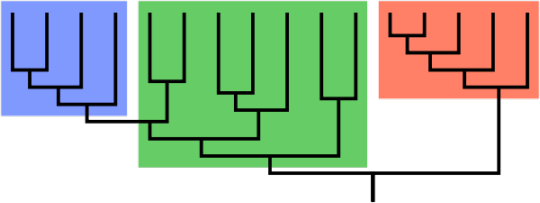
From Wikipedia. The blue and red group are monophyletic and clades, as is the blue + green supergroup; however, the green group on its own is paraphyletic, and may be a grade.
There are two ways to define a clade: an exclusive approach (“the narrowest/most exclusive clade including both the species A and B”) and an inclusive approach (“the broadest/most inclusive clade including the species A but not B”).
A exclusive clade in which the species A and B are both currently living is called a crown group. Aves is such a group (look at the red zone in the diagram), as all the sub-groups that branch from its roots have living members; there is no fully extinct sub-group that is a sister to the rest. It could be defined as “the narrowest possible clade including both ostriches and sparrows”, for example. (In reality, Aves is not a crown group as it includes some basal extinct species, but let’s pretend it does not.)
A total group or pan-group is an extension of a crown group that also includes all extinct species that are closer to it than to any other living species. We could expand Aves to Pan-Aves (the orange zone in the diagram) by defining it as “the broadest possible clade that includes birds but not crocodiles”, crocodiles being the closest still-living relatives of birds.
A stem group is simply the difference of a total group and a crown group: stem-Aves (the yellow zone in the diagram) is the set of all members of Pan-Aves that are not members of Aves, that is, everything that is not a bird whose closest living relative is a bird. “Mammal-like reptiles” could also be described as stem-Mammalia. While crown groups and total groups are monophyletic, stem groups are of course paraphyletic.
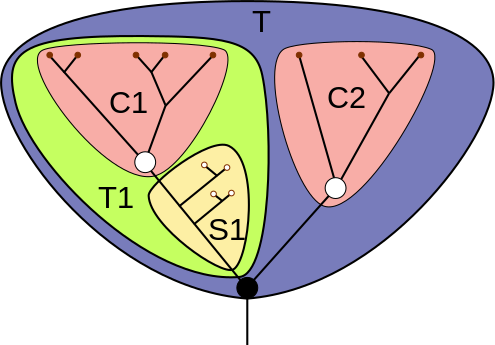
From Wikipedia. Red dots are living species, yellow dots extinct species. C1 and C2 are crown groups; T1 is C1's total group, while S1 is C1's stem group.
Now, symbols I will use to write about present and past taxa. Paraphyletic groups are preceded by an asterisk, e.g. *Nautiloidea. Sometimes I write (*?) or such when the paraphyletic status of a group is uncertain.
Sometimes I provide more than a name for a given group, separated by a slash, e.g. Magnoliophyta/Angiospermae. In some cases the two names are not exactly synonyms, and one might be very slighty more restrictive than the other, but choosing one over the other would not change the scheme I’m showing here.
Quotes surround a name that is no longer used, e.g. “Heliozoa”. I also use quotes to provide translations for some names, e.g. Cyclostomi (“circular mouth”).
As is standard use in taxonomy, the cross-like dagger mark (†) is used to indicate extinct groups, e.g. † Ornithischia. When applied to a paraphyletic group it does not exclude that some descendant species that are not included in it might still exist, e.g. † *Placodermi (which include the ancestors of every living cartilaginous and bony fishes).
5 notes
·
View notes
Text
branchial arch
Branchial arches, or gill arches, are a series of bony “loops” present in fish, which support the gills. As gills are the primitive condition of vertebrates, all vertebrate embryos develop pharyngeal arches, though the eventual fate of these arches varies between taxa. In jawed fish, the first arch develops into the jaws, the second into the hyomandibular complex, with the posterior arches supporting gills. In amphibians and reptiles, many elements are lost including the gill arches, resulting in only the oral jaws and a hyoid apparatus remaining. In mammals and birds, the hyoid is still more simplified. All basal vertebrates breathe with gills. The gills are carried right behind the head, bordering the posterior margins of a series of openings from the esophagus to the exterior. Each gill is supported by a cartilagenous or bony gill arch. Bony fish have three pairs of arches, cartilaginous fish have five to seven pairs, and primitive jawless fish have seven. The vertebrate ancestor no doubt had more arches, as some of their chordate relatives have more than 50 pairs of gills. In amphibians and some primitive bony fishes, the larvae bear external gills, branching off from the gill arches. These are reduced in adulthood, their function taken over by the gills proper in fishes and by lungs in most amphibians. Some amphibans retain the external larval gills in adulthood, the complex internal gill system as seen in fish apparently being irrevocably lost very early in the evolution of tetrapods.
Originally published here: https://forestray.dentist/kb/branchial-arch/
0 notes
Text
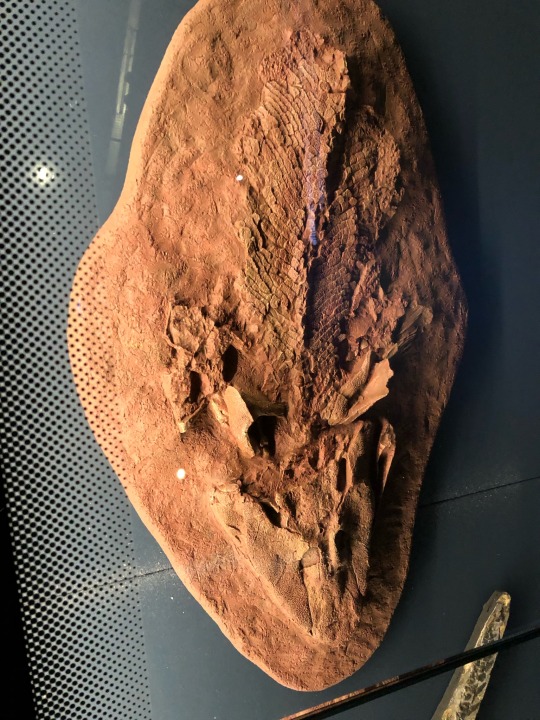
Tiktaalik!
1 note
·
View note
Text
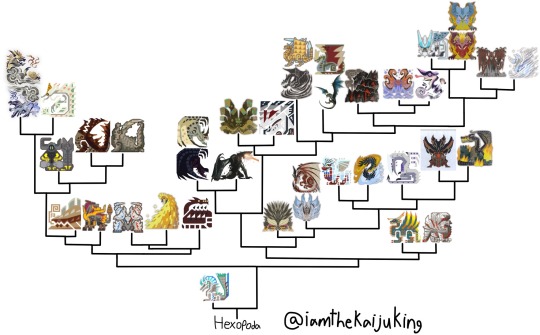
An (outdated) cladogram of “True” elder dragons I created (newer version can be found here). Given the fact that there seems to be many gaps in terms of elder dragon relations, and that many existing “true” elder dragons are quite different from each other, this is the best I could do. I included frontier dragons for a larger sample size, which makes things easier.
In this cladogram, elder dragons have a common ancestry with piscine wyverns. The hypothetical ancestor of elder dragons, piscine wyverns, and “piscine leviathans” (somna) was probably a quadrupedal Actinistian equivalent to tetrapods with very large paired dorsal fins. The ones that lead to piscine leviathans and elder dragons might have modified these paired dorsal fins into jointed limbs to be used used for movement like their other limbs, but then they became vestigial in some piscine leviathans (somna). Or maybe only the elder dragon line ones modified their dorsal fins in such a way.
One of the defining features of elder dragons are their horns, which often serve as some sort of modulator for their powers. Many elders also go through drastic changes throughout their life. Coupled with the hypothetical fish ancestry, I purpose that many elder dragons might have “tadpole” stages like amphibians, or go through several drastically different stages in their life cycle.
If creatures like somnacanth are the closest relatives, then Shantien might be the most basal existing elder dragon. I think it might have descended from elder dragons that hadn’t quite evolved their fins into wings yet. It’s “wing” arms are reduced into fins once again though.
From here I split elder dragons into two main groups. Winged elder dragons, which continued to develop their paired dorsal fins into powerful limbs that could be useful for flight, and Drakes, which lost their paired dorsal fins. I’ll start with drakes first since it’s the smaller group.
Eruzerion, Kulve, and Lao I felt seemed to be a sort of natural progression from a semi-sprawling almost fanged wyvern-like bauplan to a more erect posture. Eruzerion and Kulve also have sprawled forearms, massive curled horns, and powerful heat/fire abilities. Lao is the most derived of the three existing members of the group, and Kulve is likely closer to Eruzerion than it is to Lao. Kulve’s golden mantle supports my theory that the world of monster hunter is incredibly mineral rich, as its mantle and the habitat it’s initially found in likely has more gold than our entire earth does alone. The world of monster hunter would have to have such massive amounts of minerals if there’s many geovorous organisms and dragons like Kulve running around with mantles made of several hundred thousand pounds of gold just for display. I know Lao is canonically close to Zorah, but I’m obviously not following canon and I can’t really see many similarities between them aside from them being “the big omnipedal kaiju dragons”. There’s some subtle differences in their anatomy, and Lao lacks wings while Zorah has vestigial ones.
Inagami is interesting as it could work in many places in the drake family, and might even be a distant Kirin relative. It could work as a distant Lao relative, but I put it as a sister group to ocean drakes (although I’m starting to second guess this decision).
Tartaronis is the last remaining member of a sister group to all existing ocean drakes, and is incredibly derived. Several million years ago when the sea levels were higher they might have lived in shallow seas. As the sea levels dropped they might have switched to swimming in the sand.
Ceadeus is probably a textbook ocean drake and the only existing one that’s still aquatic. I have it as a sister group to the Mohrans. I used goldbeard’s icon since goldbeards are implied to be adults.
There’s not much to say about the Mohrans other than the fact they too live in the sand like Tartaronis, quite likely for similar reasons. They probably use sonic frequencies to liquifact the sand so they can swim through it.
Amatsu and the sky serpents Narwa and Ibushi are sister genre, although they’re still probably quite distant. The sky serpents seem to lack tongues, although I think their pharyngeal jaws might be derived from their tongues. Given the fact that Amatsu makes whale-like calls, the serpents communicate via ultrasound, and the Mohrans might use sound to make sand easy to swim through, sonic communication might have been ancestral to ocean drakes. It’s become lost in Amatsu and repurposed in the Mohrans and Tartaronis.
Over on the other side of the tree, I placed Rukodiora and Harudomerugu as the most basal winged dragons. Their wings seem to still be relatively simple in anatomy, although whether or not this is a basal or derived trait, I could not tell you. What makes them really stand out though, is that they have multiple paired dorsal fins. Their ancestors likely acquired a series of mutations that allowed this trait to manifest. Somnacanth also has several paired dorsal fins too, so something similar could have happened.
Nergigante, the Jiivas, and the black dragons I’ve grouped together as a very unique group due to their power and regeneration. The ancestral dragon of this group was likely a dragon that specialized in hunting other elder dragons. Access to such nutritious prey and bountiful amounts of bioenergy would allow for the evolution of incredibly fast and extensive regeneration as well as powerful elemental abilities. Eventually some members switched to subsisting off of bioenergy alone (such as the Jiivas) and might have searched for habits rich in bioenergy. The black dragons are the culmination of this increasing trend of absurdly powerful predatory dragons that subsist mostly off of bioenergy and go to the most remote locations in search of this resource. They likely don’t have very high population densities, and might be so rare that they might have opted out of reproducing sexually and instead switched to several asexual methods. Given that Alatreon and Merphistophelin have access to all elements and are representatives of the two major black dragon families, the ancestral black dragon might have been the same. With only later black dragons like fatalis specializing for a single element. I know fatalis is canonically the ancestor of all dragons, and while I don’t agree with this statement, I can see why people would think so. Its lizard-y look, mysterious nature, incredible power, and long lifespan would give the impression of a sort of ancestral god.
The rest of the dragons are in a group with each other largely because I can’t find a good place to put them. It’s a largely wastebasket taxon, but there are some groupings within it.
The Magalas and Gog share obvious ancestry.
I placed Shara with Valstrax as a relative because you can see something come out of shara’s fingers and something is lighting up in shara’s triceps. Shara also has holes in its chest that could lead to a massive respiratory system like valstrax. So both might be united under a branching respiratory system that opens up in their chest and fingers. Valstrax adapted it for combustion and Shara for burrowing.
Kushala is well… Kushala. There’s not any other existing elder dragon with an exoskeleton. Interestingly, some Kushala Daora mutate and become Garuba Daora.
Guanzoroumu I have placed with Egyurasu because there’s an interesting theory that @eightleggedfiend suggests, and said theory is why I omitted Egyurasu from my flying wyvern cladogram. There is good reason to believe that Egyurasu are actually juvenile Guanzoroumu. They share way too many anatomical similarities for their similar appearance to be convergent evolution, and there’s not many good reasons why a powerful elder dragon would allow smaller less powerful monsters to constantly encircle it. Some elders have been known to go through drastic life changes, so maybe Guanzoroumu and Egyurasu are another example of that.
Initially I grouped Chameleos with Zorah since they both have a single large nasal horn, fat tails and lizard like hands (I know the only limbs with lizard hands on Zorah are it’s wings, but the other ones could have lost their lizard-ness as an adaptation for weight bearing). But eightleggedfiend changed my mind. They backed up the canon idea of namielle being related to chameleos by mentioning both of them are EDs with bioluminescence, color changing abilities, and control over electricity.
The Stras are a sister species to Toa Tesukatora in this tree (canonically they’re the direct descendant of Toa but given their wildly different elemental powers I doubt it). The Stras have the fastest land speed of any elder dragon for their size.
Vaal and Velkhana form a group in the cladogram. I put the Vs together due to their similar torso and limb build, tapering tails, and hoods on their neck. Vaal actually has a small hood if you look close, and so does Velk too (in fact that’s where most of its ice crown sits). Vaal is obviously more derived though.
#sketches#monster hunter#speculative biology#speculative evolution#biology#sketch#monsterhunter#elder dragons#elder dragon#cladograms#cladogram#taxonomy#phylogeny#eightleggedfiend
56 notes
·
View notes